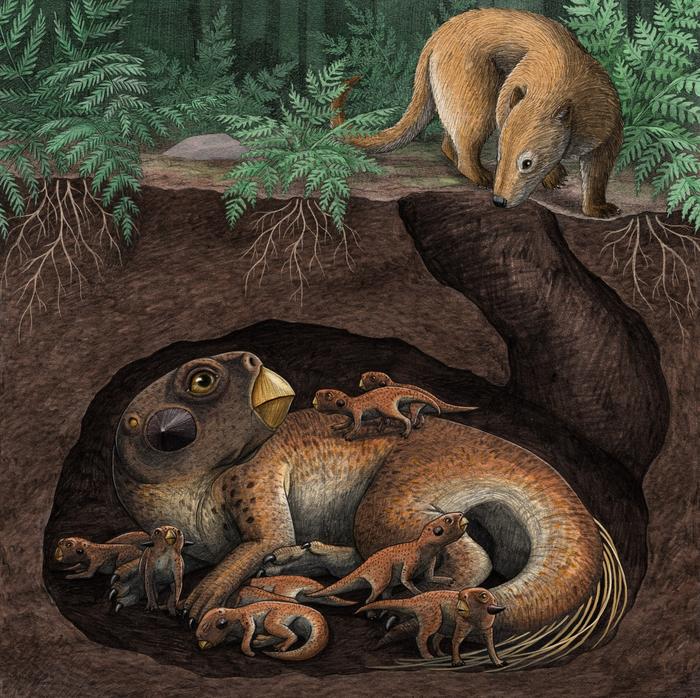Cretaceous 'Pompeii' of China isn't what we thought
For many years, the Yixian Formation has been referred to as the "Pompeii" of the dinosaur world. An early Cretaceous geological formation situated in northeast China, it boasts some of the world's most incredibly well-preserved fossils and is a treasure trove of information for paleontologists, giving us a glimpse into life 130 million to 120 million years ago.
Researchers believed the remains were preserved by volcanic ash from eruptions, much like how Mount Vesuvius buried the city of Pompeii in 6 metres (19 feet) of ash in 79 AD.
Suggests an unexpected turn of events: these ancient beings could have been hidden in collapsed tunnels, rather than being sealed by volcanic eruptions.
with a small dinosaur.
The fossils come in two types: flattened remains found in lake deposits and nearly lifelike three-dimensional skeletons. These skeletons were initially thought to be the result of sudden volcanic eruptions that buried them in volcanic ash, effectively preserving them in a state of suspended time.
Related: Last gasps of a titanic struggle between dinosaurs and mammals have been frozen in time by volcanic ash, a remarkable discovery that offers a unique glimpse into the ancient world.
The majority of such fossils were probably preserved by a less dramatic factor.
In order to uncover the secrets of how the fossils were preserved, experts examined zircon samples that were taken from them. Zircon is a mineral commonly found in volcanic rocks and fossils, which traps uranium when it forms, but excludes lead. Uranium is radioactive and very slowly turns into lead over millions of years.
By calculating the uranium to lead ratio in zircons, the researchers discovered that the fossils found in the Yixian Formation were laid down remarkably quickly, approximately 125.8 million years ago, over a brief span of just 93,000 years - far sooner than initially estimated.
During this period, an unexpected rapid accumulation of sediments occurred in lakes and on land due to three periods of wet weather, causing many deceased creatures to be quickly buried and restricting the oxygen supply that normally triggers decomposition.

The most marked effect was evident in lakes, where sediments accumulated at a fast pace, allowing soft tissues to be preserved with great clarity.
A paleontologist at the Lamont-Doherty Earth Observatory, part of Columbia Climate School, highlights that such a disaster is highly improbable because, as they explain, lahars are incredibly destructive and would likely tear through anything – living or dead – in their path.
One popular idea is that fast-moving waves of extremely hot ash and gas, referred to as pyroclastic flows, buried the fossils, just like Mount Vesuvius encased the people of Pompeii. These flows are infamous for overwhelming the residents of Pompeii, after which they sealed their bodies under layers of ash, effectively preserving their positions. The intense heat responsible for the pyroclastic flows caused victims to adopt a posture known as "pugilistic", with their limbs severely twisted inwards and their muscle functions and bodily fluids being disrupted.
Scientists point out that, although the Yixian Formation contains deep layers of volcanic ash, lava, and magma, the fossils discovered do not exhibit the characteristic signs typically found in catastrophes such as Pompeii. The researchers suggest that if the Yixian animals had been buried by pyroclastic flows, their feathers, fur, and other tissues would probably have been completely destroyed.
Many of the Yixian animals discovered were curled up in comfort with their limbs wrapped around their bodies, much like they would be whilst asleep when they passed away. The scientists suggest that the cause of death was a sudden cave-in of the burrows, possibly triggered by large dinosaurs exerting pressure from above during wet and unstable ground conditions.
'These could be the most significant dinosaur discoveries in 120 years,' Olsen stated. 'However, a significant human tendency has been highlighted by their method of preservation - the tendency to attribute remarkable causes, such as miracles, to otherwise ordinary events when their origins are unknown. In reality, these fossils merely represent a snapshot of everyday mortalities that occurred in normal circumstances over a relatively short period of time.'
Post a Comment for "Cretaceous 'Pompeii' of China isn't what we thought"